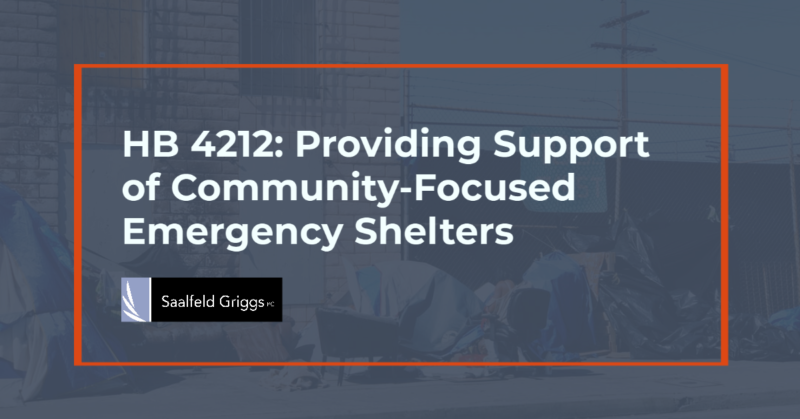By Margaret Gander-Vo, Attorney in the Real Estate & Land Use Practice Group
The 2020 Legislative Special Session focused largely on addressing the pressing emergencies facing the State. However, several bills that were stalled by the Republican lead walkout in the regular session reemerged and were passed by both houses. One of which is Speaker Kotek’s proposed legislation aimed at helping local jurisdictions provide emergency shelters and provide funding to help alleviate homelessness. The act designated as HB 4212 utilizes three mechanisms: authorizing “super siting” of qualified emergency shelters; funding for programs and assistance; and funding the development of local navigation centers.
The proposed act defines “Emergency Shelter” as a building that provides shelter on a temporary basis for individuals and families who lack permanent housing. Under the act, local jurisdictions will be required to approve an emergency shelter for operation on any property if the Emergency Shelter can meet the following requirements: provides sleeping and restroom facilities; complies with applicable building codes; is located within an Urban Growth Boundary or in a rural residential zone; will not result in a new building within an area identified by the state as within a natural disaster or hazard area ( e.g. flood plains or mapped environmental health hazards) unless the building complies with regulations directly related to the hazard; has adequate transportation or access to commercial and medical services; and will not result in an unreasonable risk to public health or safety. In its current form, the act will allow local governments and organizations to take advantage of available buildings without requiring an application for a zone change or comprehensive plan amendment for the underlying property. The hope is that by removing these barriers to formation, shelters will be able to establish themselves more quickly and in areas where they can be most effective. By focusing on transportation and proximity to services, the hope is that local stakeholders will be able to find sites that both keep people sheltered and connect them to services that will help individuals transition into permanent housing. An unconditioned, housing first program would allow opportunities for something similar to large scale programs in Salt Lake City, Santa Fe, and other municipalities with promising results. Smaller-scale projects have already been successful in Oregon municipalities and have been growing in popularity over the past few years, however, they have been unable to keep pace with the growing need and struggle with funding.
Along with paving the way for the development of more shelters in more areas, the proposed act appropriates funding to Housing and Community Services Department for the establishment of an Emergency Housing Account for funding grants and technical assistance for organizations working to develop emergency shelters with a low barrier to entry, support facilities, or rapid rehousing support and services. The funding allocated to these programs will be spread throughout the state in order to provide services to every region within Oregon, with priority given to those regions identified as “highest need” in the August 2019 Oregon Statewide Shelter Study. This much-needed funding will be available not only to help develop emergency shelter facilities but will also offer on-going programming grants that will provide a steady funding stream for organizations attempting to address chronic homelessness throughout the state. The act also provides funding for programs working to prevent individuals from falling into homelessness, whether through emergency rent assistance, utility payments, or landlord partnerships designed to help keep people in their homes, with special focus on veterans and vulnerable populations.
Additional funding will be appropriated to the Department of Administrative Services for distribution to Bend, Eugene, Salem, and Medford, as well as Yamhill and Lane Counties for the development of navigation centers. Under the act, a navigation center is defined as “a low-barrier Emergency Shelter . . . . that is open seven days per week and connects individuals and families with health services, permanent housing, and public benefits.” The designated jurisdictions will receive funding from the Department of Administrative Services to plan and design their center, obtain the building or property, and operate or contract for the operation of the center by the time outlined in the act. The proposed centers are designed to target areas identified as the highest need in order to meet the greatest need and provide the greatest impact possible.
Homelessness is a wide-spread and multi-faceted issue, and any policy will likely have unintended consequences. Providing funding for targeted, community programs and shelters will provide direct support to those in need and is a necessary precursor to the enforcement of sit-lie laws and bans of public camping. The homelessness crises have escalated sharply over the past decade, and will likely be worse in the coming years with the economy entering into a recession that is complicated by the ongoing COVID-19 pandemic.
Margaret Gander-Vo is an attorney in the Real Estate & Land Use practice group and a member of the Dental Industry Group. The information in this article is not intended to provide legal advice. For professional consultation, please contact Margaret at Saalfeld Griggs PC. 503.399.1070. margaret@sglaw.com © 2020 Saalfeld Griggs PC

